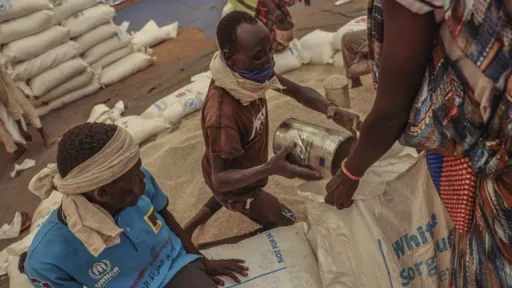By Firmain Eric Mbadinga
Salt to taste. No savoury recipe is complete without this ubiquitous phrase, illustrating the importance of nature's most commonly found seasoning in every cuisine.
Like a magical powder, salt has the power to enhance a dish, just as an extra sprinkling can make it unpalatable.
To ensure flavour without compromising health, the World Health Organisation (WHO) recommends consuming less than 5 grams of salt daily for adults and even less for children aged 2 to 15. This salt must also be rich in iodine to ensure a healthy balance.
The last criterion requires salt farming to comply with rules and production techniques to guarantee consumers a quality product.
Local economy
In Senegal, Fatick in the central region and Sédhiou in the south are part of a traditional salt production hub that drives the local economy. Most of those who work in the salt pans that mark this terrain are women.
Louise Laroye, in charge of mission development at the Univers-Sel association, has been involved in various initiatives to support salt pans in the towns of Palmarin, Djilasse and Loul Sésséne, all located in the coastal zone of the Fatick region.
Univers-Sel works alongside small-scale producers to modernise production techniques so that the salt produced is of quality and less polluting.
In the past four years, Univers-Sel has focused on two projects aimed at local women producers.
"We have the Ndappe O Diem project, which means "salt granary" in the Serer language, that started in October 2022. There's also the Resilao project, which operates solely in Palmarin and was launched in February this year," Louise tells TRT Afrika.
Both projects, initiated by the National Nutrition Development Council, involve collaboration between salt farmers in Senegal and other countries.
"The structure used to be previously called the Cellule de Lutte Contre la Malnutrition (Malnutrition Control Unit), supporting producers mainly in the fight against iodine deficiency. At the time, the unit was having difficulty mobilising salt producers. That's when they contacted us for a study," recounts Louise.
The survey led to the 2020 launch of a two-year pilot project called APEFASS. Then came the Ndappe O Diem project.
Chequered history
Salt accounts for around 3.5% of the world's oceans. It is produced naturally when seawater is introduced into a series of basins for continuous evaporation and fractional crystallisation of the different salts.
This continues until sodium chloride precipitates in the basins. The salt is then harvested and processed according to requirements.
For many years, small-scale producers have produced salt in Africa using diverse production techniques. In Guinea-Bissau, Gambia, Niger and Senegal, solar evaporation is among the more common methods.
Serra Salt Machinery, a global company with expertise in engineering, design, manufacturing and commissioning salt equipment and plants, explains that solar evaporation is the oldest method of salt production.
Alongside this natural technique, evaporating salt by fire involves repeatedly heating salted water to high temperatures in furnaces and other containers.
According to specialists, this approach involves burning a great deal of organic matter, such as wood, which is harmful to the environment in the context of global warming.
Sustainable approach
"We don't use this technique," says Louise. "The technique of choice in Senegal, specifically in the areas where we work, differs from that in Casamance or even Guinea-Bissau. Here, we use salt pits and basins. Producers don't have to burn wood."
Univers-Sel also offers an alternative to using individual crystallisers on plastic sheeting, which avoids firing and cutting wood.
"We have been advocating this technique for several years. Thanks to the sun and the wind, we can obtain high-quality salt every day during the dry period, which runs from about January to mid-April and early May," explains Emmanuel Deniaud, the organisation's director.
Louise Demba Sarr, former president of the Federation of Salt Growers in the town of Palmarin, is among the many who have benefited from their association with Univers-Sel.
"Previously, we didn't necessarily focus on salt quality. But thanks to Univers-Sel, we now do so with practical knowledge of the relevant procedures. Earlier, we would collect and mix the first harvest, the second one, and the third into a single block. The final product was not good," Sarr tells TRT Afrika.
She notes that she and her colleagues have also developed skills to improve their sales. "Every year, people from Univers-Sel are assigned to discuss capacity-building with us."
Value-chain regulation
With Univers-Sel's help, the Senegalese government focuses on providing small-scale salt producers at the beginning of the production chain the necessary knowledge to ensure local salt is enriched with sodium through environment-friendly processes.
While sodium is an essential nutrient humans require to maintain plasma volume, acid-base balance, transmission of nerve impulses, and normal cell function, overdosing can lead to high blood pressure, which increases the risk of cardiovascular disease, gastric cancer, obesity, and other illnesses.
WHO estimates that 1.89 million deaths each year are associated with excessive sodium consumption.
According to official figures for West Africa, Senegal is the leading salt-producing country, producing almost 450,000 tonnes yearly, around 150,000 tonnes more than its neighbour Guinea-Bissau.
This value is remarkable given that Africa depends on salt imports to meet a demand estimated by UNICEF at 7,000,000 tonnes annually.
➤Click here to follow our WhatsApp channel for more stories.
























